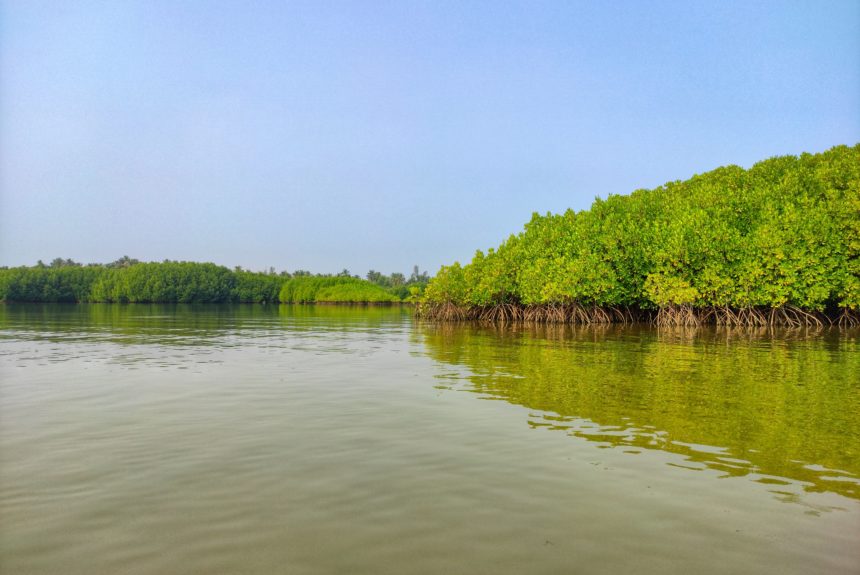Taking care of his mud crab farming plot among the mangroves along the coast of his Janashi village is a routine for Rajan Dhanawade. Over 1,000 green mud crabs are being cultivated in fiber nets placed in the mud among the mangrove roots at the beach. Every day, Rajan takes crabs in his hands, checks their weight, and offers them fish food. Rajan lives in Janashi, a village in India’s Maharashtra Ratnagiri district that overlooks the Arabian Sea.
Rajan then waits for the crabs to grow to a weight of 1-1.5 kg so he may sell them in Mumbai City, India’s financial capital, 392 km (244 mi.) away. One crab that weighs 1-1.5 kg could earn Rajan as much as Rs 1500 (US$20).
Until October 2020, Rajan, like other villagers, would cut mangroves and use them as firewood. Construction materials dumped among the mangroves, as well as household garbage used to be common, as well. Villagers only knew that mangroves, or ‘Kharphuti’ in the local Marathi language, grow in saltwater and did not know of their greater significance.
The mangrove forests, which are salt-tolerant vegetation trees and shrubs, grow between land and sea. They stabilize the coastline and reduce erosion from storm surges, current waves, tides, and great carbon sinks. In addition, they protect biodiversity by sheltering and nurturing marine life.
The Mangrove Foundation, a special cell of the Forest Department of Maharashtra, was started in 2017 to create awareness among residents of the coastal villages of all six coastal districts of Maharashtra about the benefits of this ecosystem.
As a part of their sustainability push, the Mangrove Foundation teaches villagers different techniques for oyster farming and fishing. Specifically, the Foundation helps the oyster farmers erect rectangular bamboo structures along the creeks among the mangroves.
“[The] crab farming project proved a lifesaver for all of us who are losing farms to the rising sea level,” says Rajan.
A group of ten farmers, including, Rajan, earned over Rs 150,000 (US$2027) by selling crabs in 2020 during the pandemic. “We [were] able to increase income by overcoming challenges like water reced[ing] in low tide. So we grew crabs in ditches,” Rajan says.
“The villagers have become our ally in the conservation of mangroves and biodiversity protection. They call the forest department helpline whenever they see mangroves are being cut, and officials fine the miscreants. They inform on spotting stranded sea animals like dolphins, whales, or turtles, and our teams rescue the animals. Veterinary doctors treat them if necessary before taking them back to sea,” reports Dr. Sushant Sanaye, deputy director, Livelihood Development, Mangrove Foundation.
The Mangrove Foundation has also begun to show villagers how to cultivate the plants by having them help plant new mangrove forests. “We ask villagers to bring seeds of the mangroves, and we grow saplings at the nurseries. This is the first project for the conservation of the mangrove, and hence we don’t have old records of species of mangroves. Now we cultivate 20 varieties of the mangroves,” says Dr. Sanaye.
More importantly, villagers now don’t allow trucks to dump construction material or garbage in the mangroves and regularly remove garbage and plastic at the roots of the mangroves.
In the last four years, mangrove cover in the state has increased to 353.18 sq km in 2021, up from 304 sq km in 2005. With this increase, locals have begun to notice an increase in the number of migratory birds visiting the villages. The researchers recorded the sighting of 307 different birds along the coast in Sidhudurga district alone.
Over 1750 residents across 124 villages are involved in the sustainable livelihood activities with the mangroves and collectively earned Rs 35,82,909 (US$48,417) in 2020. Villagers also say that the intensity of tides during two cyclones that hit the west coast of India was lower than in the villages without mangroves.
Varsha Torgalkar is an India-based independent journalist. She covers public health, climate change, rural economy and travel. She has written for LA Times, SCMP, Asia Democracy Chronicles, Huffington Post and many Indian news websites. She has been a fellow of Earth Journalism Network, UNICEF and National Foundation of India. She has been a recipient of the PII-ICRC award for the best story.
The views and opinions expressed are those of the author’s and do not necessarily reflect the official policy or position of C3.
